As an Amazon Associate I earn from qualifying purchases.
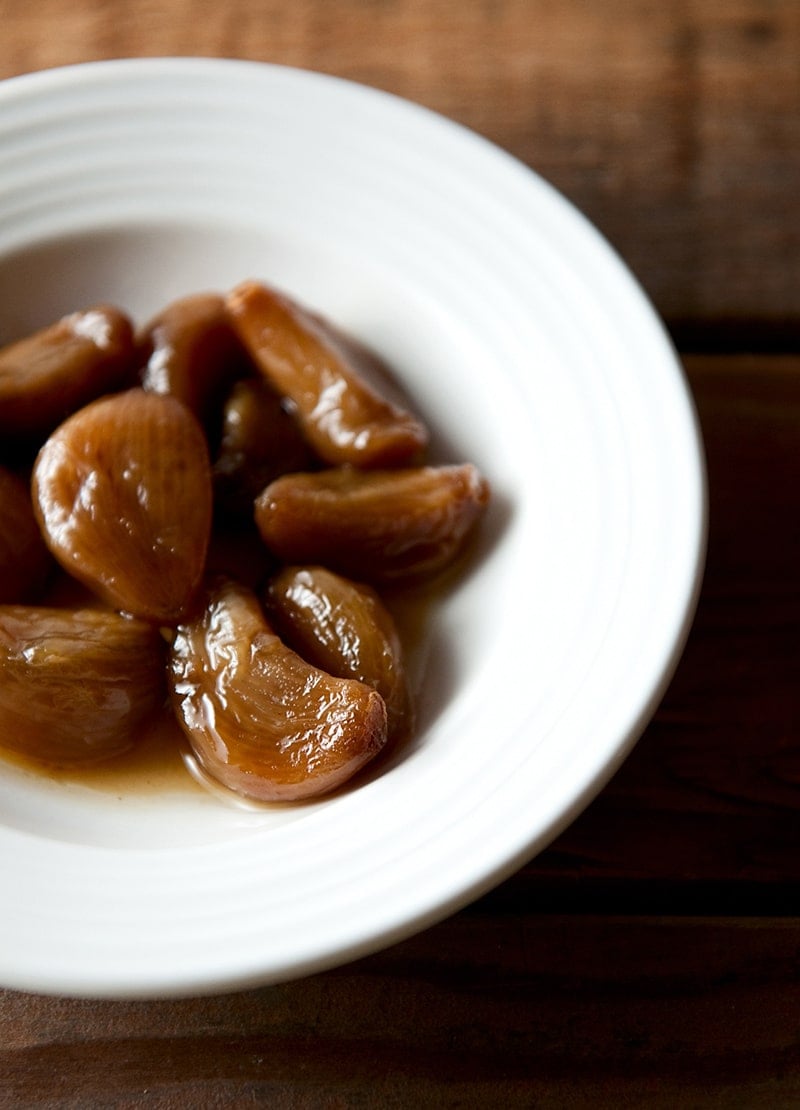
I do a lot of pickling and preserving, and I do it for many reasons: To capture abundance, to hold onto seasons past, to transform good into great. It is this last that drives me. Most preserved foods do not outshine their fresh state. Some can be just as good, only different. But a precious few foods undergo a magical transmogrification when they are preserved.
Fresh pork leg transformed into prosciutto is a classic example. As are wine and cheese from grapes and milk. So too with fresh garlic. No matter how much I love fresh garlic, it is but a shadow of these preserved cloves. Eating them for the first time was a revelation, a culinary epiphany: I must have this garlic on hand. Always.
I did not come up with this method of preserving garlic myself. It comes from my colleague Paul Virant, a fellow traveler, cook and preservation junkie who did me the honor of hosting a Hunt, Gather, Cook dinner at his Michelin-starred restaurant Vie in Chicago last fall. It was a wonderful dinner, but Paul was just as eager to show me his preservation sanctum sanctorum, tucked away in an unused room above the restaurant.
Walls of jarred deliciousness rested there. Fruits, green things, sauerkraut. Beets of all shapes and sizes. And a set of jars in the corner stuffed with what looked like roasted garlic.
Paul remarked that they were pressure-canned hardneck garlic cloves; hardneck garlic doesn’t store as well as the typical softneck you get in the supermarket, but it is vastly superior in flavor. So Paul puts up jars and jars of the stuff.
The recipe is from Paul’s book: The Preservation Kitchen: The Craft of Making and Cooking with Pickles, Preserves, and Aigre-doux. Virant’s book is one of two preservation books out now by bona fide chefs; the other, Tart and Sweet by Kelly Geary and Jessie Knadler is also excellent. (As a side note, there is a raft of canning books on the market right now, and I would add one more “must buy” to the current crop of books: Marisa McLellan’s Food in Jars.)
But Paul goes where most other canning books fear to tread: He delves into pressure canning. This preserved garlic cannot be made without a pressure canner.
I simply don’t have words to describe how wonderful this stuff is — imagine roasted garlic that holds its shape, sweet, savory, soft, unctuous and just salty enough for you to want to eat another. And another.
I like to put a few cloves on a plate with other things, as an accent. Or you can spread them on bread. Or toss them in with eggs in the morning. They are a fantastic addition to a pan sauce.
I am posting this now because it is garlic season in most of the country. Fresh garlic is all over farmer’s markets now, and while all fresh garlic is excellent, use the hardneck variety if you can find it. It has a hard central stalk in the middle, and its cloves tend to be larger than those of a softneck.
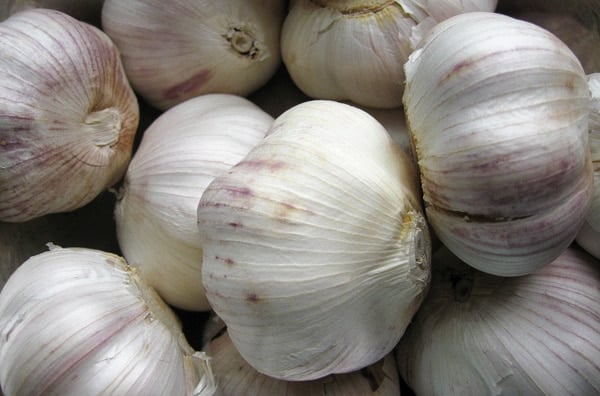
The hardest part of this entire process is peeling the cloves. But that’s not really that hard either. There is a great trick to peeling lots of garlic: Put the cloves in a bowl, top with another bowl of equal size, and shake them vigorously for about 15 seconds. The skins will all knock themselves off. (Here is a video of the process.)
The only other hurdle here is the pressure canner. If you are a hunter, angler, gardener, forager or cook, you really need to get one. They will change your life, in a good way. And all those stories of them exploding are from the 1950s. Modern pressure canners are safe and sturdy. Follow the directions carefully and you will be fine. I admit to being nervous about using the pressure canner the first few times, but I got over it.
If you make this preserved garlic, I guarantee you will, too.
Preserved Garlic
Ingredients
- 5 cups of peeled garlic cloves, about 2 pounds of whole garlic
- 1/2 cup extra-virgin olive oil
- 1 tablespoon kosher salt
- 1/2 cup sugar
- 1/3 cup sherry vinegar
Instructions
- Turn your oven to 220°F. Place 5 half-pint jars on a baking tray in the oven. (Use clean, unused lids for this recipe.) This will sterilize everything. I always put an extra jar in because yields can be variable; large garlic cloves can change things, so it's best to be ready for extra.
- In a large saute pan, heat the oil and cook the garlic cloves over medium heat. Sprinkle the salt over them. Cook, stirring often, until they begin to brown. This can take anywhere from 8 to 20 minutes, depending on the heat you're using and how moist the garlic cloves are. Once they are starting to brown, mix the sugar into the pan and continue to cook until it begins to caramelize, about 2-5 minutes.
- Add the vinegar, turn up the heat to medium-high, and cook this down for a minute or two.
- Remove the jars from the oven. Pack the garlic and the oil and juices into the jars. Leave 1 inch of headspace. Wipe the rims of the jars and seal.
- Put your pressure canner on your most powerful burner. Use your finger to wipe a film of oil around the inner edge of the canner, as this will help create an airtight seal; read your canner's directions for more detail on this. Get your tap water as hot as it will go and pour enough water into the pressure canner to come up about 2 inches. Put the jars of garlic into the canner and follow its directions to seal the canner.
- Turn the heat up to high under the pressure canner and allow it to vent for 7 minutes before setting the weight at the 10 PSI marker. Let the pressure build to 10 PSI before setting the timer. Process 10 minutes for half-pints, 20 minutes for pints. (If you are at altitude, you will need to go up to 15PSI. Follow the directions on your canner.)
- Turn off the heat and allow the PSI to return to zero before taking the weight off the steam vent. Carefully open the canner, making sure you don't get scalded by the steam. Left out the jars and let them cool before storing them in the pantry.
Notes
Nutrition
Nutrition information is automatically calculated, so should only be used as an approximation.
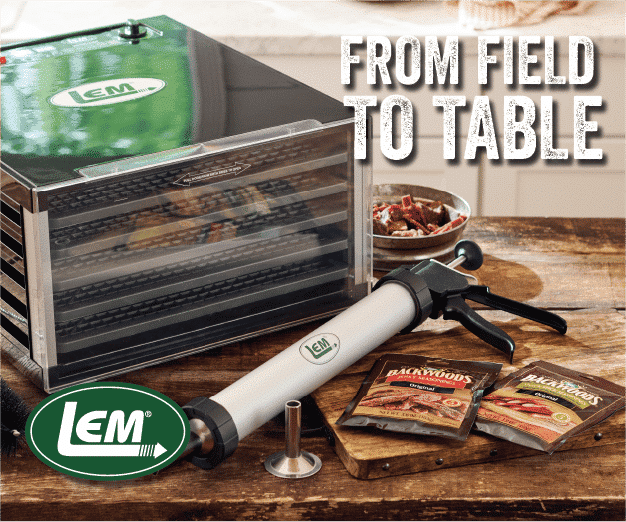
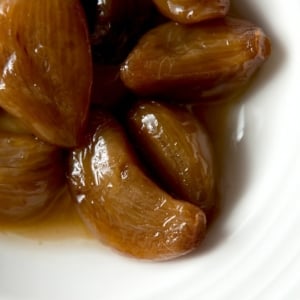
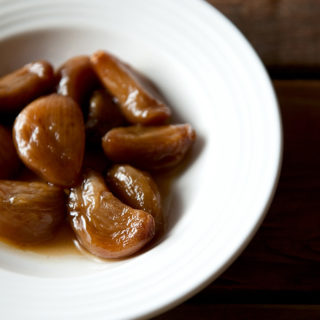
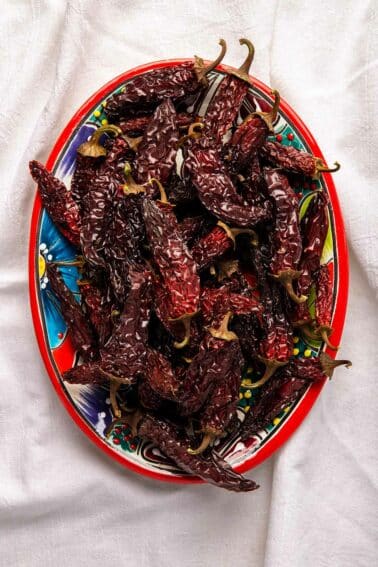
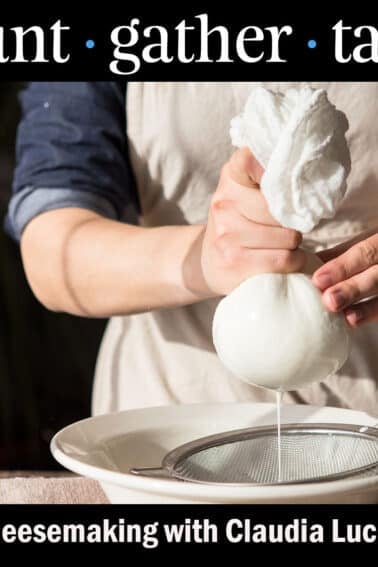


Angie: Not sure, actually. Unopened they will last a year. Opened, well, probably a few months. I can them in small jars so they get used quickly once opened…
I know that garlic oils can spoil quickly in the fridge, how long does this jar last once it’s opened? Does it have a longer life because it’s been preserved?
Interesting. I’d never thought of processing it. I grow mostly hard-neck, which does pretty well for about 5 months just hanging in the garage. At or before that point, or at least prior to the winter solstice, when whatever remains begins to sprout, I skin some cloves and dump them in a jar of olive oil. After a few months, they transmogrify to translucency. If you do not open the jar this entire time, there is a pop, and a few bubbles can be seen in the oil, so I suppose there is some very mild fermentation, but the cloves end up staying firm and tasty. Bonus: garlic oil.
Oh. My. Goodness. I am a garlic lover and user (sometimes an abuser, too). My addiction is so great that I buy garlic in bulk and use it all before it goes dry. This will be a great way to preserve some garlic already cooked; a great time-saver. Plus, I just got a pressure canner a few weeks ago and have been looking for amazing recipes. I will be trying this one; thanks!
The Modernist Cuisine folks have a similar recipe with a different process. They use a pressure cooker, and recommend refrigeration afterwards:
https://modernistcuisine.com/recipes/garlic-confit/
Mark, I like the idea of canning it, but I need more ideas about how to use it in my cooking. Can I ever substitute it for other garlic? Slice it into recipes? My garlic crop looks good this year!
luv your philosophy about food…so glad i found your site…will be following your writing for more ways to preserve the great flavors of real food….thanx for sharing your experiences with wild foods and real ingredients…will be looking up the cook books you mentions…thanx again….annie
Hank, glad to find this discussion AND your delicious recipe!
I wanted to pop in to say that there are pressure cooker/canners for sale. These are made of stainless steel (not aluminum) and are relatively small (10L) compared to your average canner. I don’t have one but I think you can fit and process four pint jars.
This type of pressure cooker allows the occasional canner to reap the benefits of pressure cooking the rest of the year – or every night to make dinner.
And speaking of garlic, here is my pressure steamed garlic – only 20 minutes from beginning to end. You can use this for instant gratification while putting up your canned garlic. ; )
The Stinking Rose – perfectly roasted garlic in 20 minutes
https://www.hippressurecooking.com/2012/02/stinking-rose-perfectly-roasted-garlic.html
Ciao!
L
This sounds GREAT! I can’t wait to try this! Thanks for the idea.
Your preserved garlic looks amazing and you’ve totally sold it! I recently bought a pressure canner from the US as in the UK it is rare to find anyone who knows about canning never mind pressure canning. Also have a large bed of hardneck garlic growing and the scapes are just starting to show, so this recipe will definitely be one to try.
I have fermented black garlic using a slow cooker and wrote a bit about it here: https://bit.ly/selRk0 The taste of that is exceptional and my first batch mistakenly dried out so I ground the cloves to a powder and sprinkle it on just about everything.
Great post Thanks.
Marie: The amount of oil in this recipe is not a problem. If you could see the sealed jars, you’d see that the garlic cloves are not even really submerged in the oil, so I don’t have that problem. But you are right in a general sense — too much oil can break the seal.
If that should ever happen, just put the stuff in the fridge and eat it before it goes bad.
Yum!
I’m not a pressure canning expert by any means, but I wonder about the amount of oil used here. Oil can boil up during the canning process and affect the seal. If it gets in between the glass and the lids, you could have a problem.
Just listen for the pop when opening, I suppose? I actually discovered this problem with oil when investigating canning hummus (which sounds wasteful, but I used to cook for groups all the time and is handy to have the stuff on hand). Instead, I can chickpeas with garlic and sesame, and then add the citrus and oil when I blend it up.
I also imagine this is why recipes say to skim the fat before canning chicken and beef broth.
But could be wrong! 🙂
Oh, Hank – thank you! We bought a pressure canner last year and put up carrots, green beans, sweet corn and regularly can our own chicken and beef stock. I had no idea the garlic we’d been getting from our local farmers was hard neck, but you’re right – it’s started showing up at the markets here in Ohio. I am going to buy as much as I can get my hands on now; this looks marvelous!
Christina: Yes, that’s what I mean. You can pickle garlic with a boiling water bath, but there is not enough vinegar in this recipe to safely can it without a pressure canner. A pressure canner does work on the stovetop, but it is a special device, not just a pot of boiling water.
Sorry for posting again Hank, but I noticed that you say you can only preserve garlic using a pressure-canner….meaning I can’t use the old fashion stove top method? Thanks!
Love the use (and new to me word) of transmogrification! Your preserved garlic recipe sounds great, we love garlic and this will definitely introduce to a new level of flavor. I second the read of the book Extra Virginity – very good.
Ed: That’s a cool site, but it’s about pressure cooking, not canning. They are two very different things. Wish there was a similar site for pressure canning…
I went from never preserving anything, because I didn’t have anyone to teach me and was afraid to try on my own, to now wanting to can and dehydrate everything i find in abundance. All it took was a single lemon fig jam recipe that pushed me over the edge, and now I can’t get enough. I have been thinking about a pressure canner for a while now, and this post gives me one more reason that it is a good idea. I am the first to admit I have a thing for kitchen tools, so I try to put them off until I think I might actually use it, and this summer is shaping up to be a good one for abundance. Just went this morning to pick wild plum cherries which you taught me about on this blog a few summers ago. Anyway, thanks for one more great idea,and cookbook rec!
Hank,
Looks like you’ve got another winner! I can’t wait to try it. Two comments. You mentioned olive oil. I suggest you add a link to the book “Extra Virginity: The Sublime and Scandalous World of Olive Oil” by Tom Mueller to your website. I highly, highly recommend you read this book. It is eye opening.
I don’t know if this is out of bounds, but you should consider adding a link to http://www.hippressurecooking.com which is devoted to pressure cooking. I’m enjoying the hell out pressure cooking as a result of this site.
Looking forward to your next post!
Hi, I grow garlic every Year in Upstate N.Y. all hardneck (mostly German Red). I get it from the Hudson Valley Garlic Fest and I store mine in a Omaha cooler in my shed it’s about 4″ thick and keep my Garlic fresh till spring. Just thought I would share it with you Love your site. Thanks.